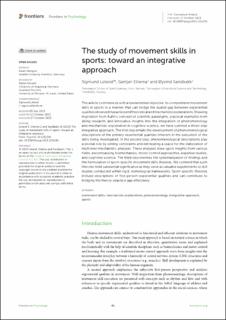| dc.contributor.author | Loland, Sigmund | |
| dc.contributor.author | Ettema, Gertjan | |
| dc.contributor.author | Sandbakk, Øyvind Bucher | |
| dc.date.accessioned | 2024-02-09T11:55:11Z | |
| dc.date.available | 2024-02-09T11:55:11Z | |
| dc.date.created | 2023-11-28T12:54:42Z | |
| dc.date.issued | 2023 | |
| dc.identifier.citation | Frontiers in Psychology. 2023, 14, Artikkel 1252201. | en_US |
| dc.identifier.issn | 1664-1078 | |
| dc.identifier.uri | https://hdl.handle.net/11250/3116598 | |
| dc.description | This is an open-access article distributed under the terms of the Creative Commons Attribution License (CC BY). The use, distribution or reproduction in other forums is permitted, provided the original author(s) and the copyright owner(s) are credited and that the original publication in this journal is cited, in accordance with accepted academic practice. No use, distribution or reproduction is permitted which does not comply with these terms. | en_US |
| dc.description.abstract | The article commences with a fundamental objective: to comprehend movement skills in sports in a manner that can bridge the dualist gap between experiential qualities observed in practice and theoretical and mechanistic explanations. Drawing inspiration from Kuhn’s concept of scientific paradigms, practical examples from skiing research, and innovative insights into the integration of phenomenology and mechanistic explanation in cognitive science, we have outlined a three-step integrative approach. The first step entails the development of phenomenological descriptions of the primary experiential qualities inherent in the execution of the skills being investigated. In the second step, phenomenological descriptions play a pivotal role by setting constraints and delineating a space for the elaboration of multilevel mechanistic analyses. These analyses draw upon insights from various fields, encompassing biomechanics, motor control approaches, expertise studies, and cognitive science. The third step involves the systematization of findings and the formulation of sport-specific movement skills theories. We contend that such theories hold substantial significance as they serve as valuable supplements to skill studies conducted within rigid, nomological frameworks. Sport-specific theories include descriptions of first-person experiential qualities and can contribute to bridging the theory-practice gap effectively. | en_US |
| dc.language.iso | eng | en_US |
| dc.subject | integrative approach | en_US |
| dc.subject | mechanistic explanations | en_US |
| dc.subject | movement skills | en_US |
| dc.subject | phenomenology | en_US |
| dc.subject | sports | en_US |
| dc.title | The study of movement skills in sports: Toward an integrative approach | en_US |
| dc.type | Peer reviewed | en_US |
| dc.type | Journal article | en_US |
| dc.description.version | publishedVersion | en_US |
| dc.rights.holder | © 2023 Loland, Ettema and Sandbakk | en_US |
| dc.source.pagenumber | 8 | en_US |
| dc.source.volume | 14 | en_US |
| dc.source.journal | Frontiers in Psychology | en_US |
| dc.identifier.doi | 10.3389/fpsyg.2023.1252201 | |
| dc.identifier.cristin | 2203796 | |
| dc.description.localcode | Institutt for idrett og samfunnsvitenskap / Department of Sport and Social Sciences | en_US |
| dc.source.articlenumber | 1252201 | en_US |
| cristin.ispublished | true | |
| cristin.fulltext | original | |
| cristin.qualitycode | 1 | |
